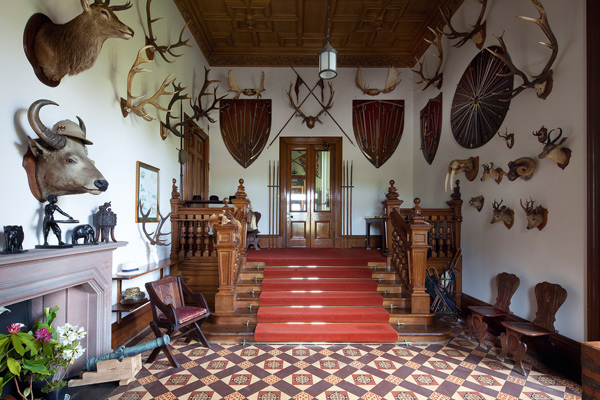It is no mean feat to produce a publication of the type that used to be described as ‘a coffee-table book’, devoted to the subject of great Scottish houses, and manage to find a fresh slant on a genre that has illustrated and described country houses for decades. James Knox and his photographer, James Fennell, have succeeded in doing just that. Whilst I might wonder if the coffee-table is still a must-have piece of furniture there is no doubt that this book is a feast for the eyes. Images shot in natural light provide luscious accompaniment to the text which achieves an easy harmony of informative history with light-hearted family and personal references.
With dozens of houses and castles throughout Scotland to choose from, the selection of just ten must have been the first challenge for the authors. Whilst some are probably obvious (Bowhill, the House of the Binns), others are possibly less familiar (Balcaskie, Lochinch Castle), and it is a pleasure to see Dumfries House take its place in the middle of this cavalcade of superlative examples of Scottish architectural history from the early 17th to early 20th centuries. Dramatic intervention by the Prince of Wales in 2007 to prevent the sale of the house and the break-up of its contents allows us a rare chance to see, at Dumfries House, set in a bleak part of Ayrshire, a marriage between the exquisite architecture of the Adam brothers Robert and John, and an extraordinary collection of both Chippendale and Scottish rococo furniture commissioned specifically for the Bute family.
The second challenge for Knox was to create succinct text for each house. At a ratio of four pages of description to some 16 pages of lush photography he was on his mettle. An architectural historian with a nice eye for family history detail and, one suspects, more than a passing acquaintance with the owners, Knox is more than equal to the task, providing a colourful insight to the houses and their families from their early origins to the present day.
His writing is at once anecdotal (the ‘ghastly paintings’ at Ballindalloch turn out to be Spanish masterpieces) and a fluent description of key moments in Scottish architectural history, as in the creation of Arniston in Midlothian by William Adam, with its extraordinary stuccoed double-height entrance hall, for the Dundas family. The overwhelming impression is of owners or custodians passionate about their historical inheritance. By no means can all the houses be identified as the work of recorded architects, although William Bruce, William Adam and his two sons Robert and John, and Robert Lorimer, all Scottish architects of world-renown, are represented. Furthermore — and frustratingly — they are not all regularly open to the public, so the photographs are essential.
Particularly pleasing are the images of the gardens and landscapes surrounding the houses. Aerial views illustrate the contextual relationship of house to countryside, with details of decaying garden statuary giving more focus. Complementing exterior architectural details the interiors feature not only the grand public rooms but the vital support systems of kitchens and bathrooms. Important and recognisable portraits are juxtaposed with a good smattering of 19th- and early 20th-century family photographs — and even, in the case of Tam Dalyell at the House of the Binns, cartoons referring to his perennial West Lothian question, a nod to current topical issues.
But in addition to delightful close-ups of china decorations, intricate wood carving and complicated plasterwork there are some whimsical and ‘artful’ oddities. Why, in the library at Balcaskie, is there a wooden butler’s tray complete with an odd selection of china placed on the carpet? I am sure a servant would have provided a side-table — possibly a coffee-table. A trio of apples shadowed in slanting sunlight are placed carefully in front of a prosaic white enamel bread bin. Bedclothes are tousled as though the occupants have just left the room.
That aside, the joy of this book is the sombre and austere architecture of these houses giving way to a riot of interior colour and richness in some 220 photos with a text providing a brief but comprehensive historical and social history of the undoubted heyday of the Scottish country house.






Comments